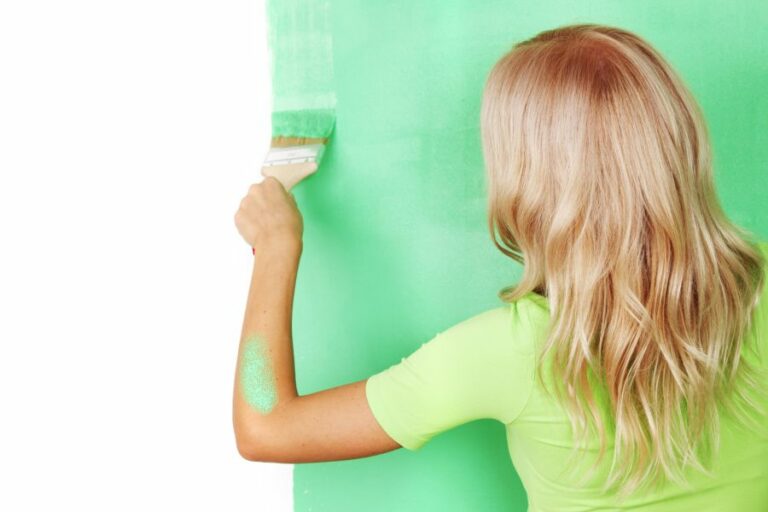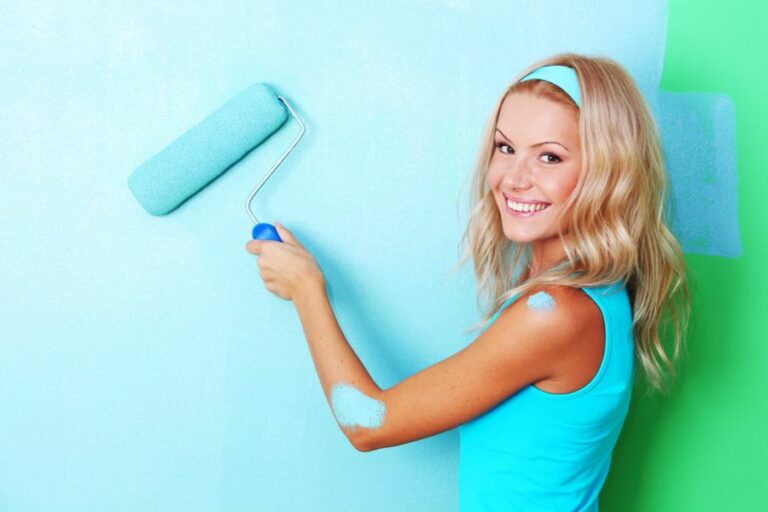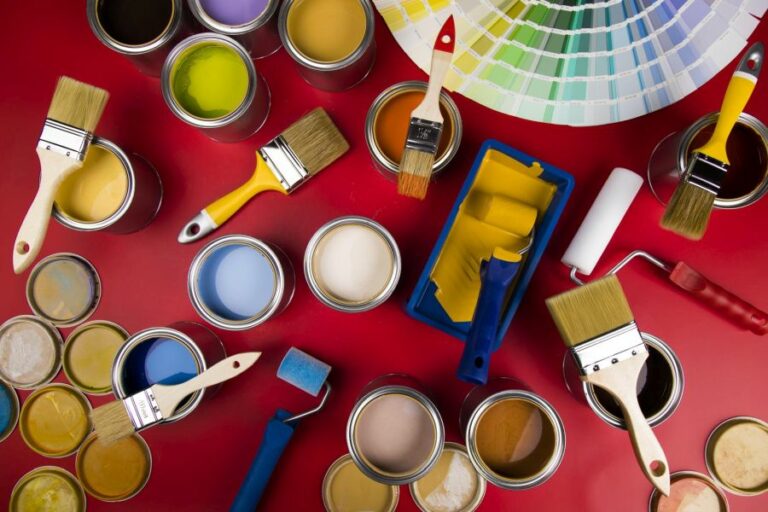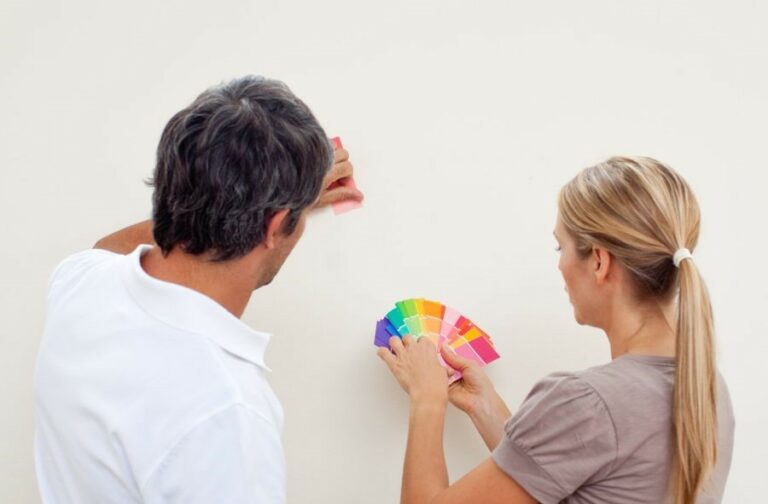Quick Drying Indoor Wall Paint, 25 Things You Should Know
Are you tired of waiting hours or days for your indoor wall paint to dry? Struggling to find a solution that will minimize the hassle and prevent your home from smelling like paint for too long? Look no further! I am excited to share a quick-drying indoor wall paint that will revolutionize how you approach painting and save you time and effort.
Quick drying indoor wall paint:
Quick-drying indoor wall paint is designed for faster drying times than traditional paints, offering reduced wait times between coats and quicker project completion. While beneficial for efficiency, it may present challenges like limited working time, sensitivity to environmental conditions, and fewer color options. Proper surface preparation, application techniques, and ventilation are essential for achieving desired results with quick-drying paint.

Discover the wonders of quick-drying indoor wall paint and transform your living space in no time! Learn about its benefits and how it can save you time, effort, and money. Want more? Read on to explore expert tips, application techniques, and top brand recommendations. Don’t miss out!
Contents
- 1 Rapid Drying Interior Wall Paint
- 2 Speediest Drying Paint for Interior Walls
- 3 Fastest Drying Paint Varieties Explained
- 4 Tips to Accelerate Interior Paint Drying
- 5 Is 20-Minute Paint Drying Possible?
Rapid Drying Interior Wall Paint
• Understanding the Basics of Quick Drying Paint
Quick-drying indoor wall paint is designed to provide faster drying times compared to traditional paints. This type of paint offers multiple benefits, including reduced wait times between coats and a quicker overall completion of your painting project.
For those who are embarking on a do-it-yourself (DIY) painting project, quick-drying paint can save you time and effort.
To achieve faster drying times, quick-drying paint typically contains smaller amounts of binder than regular paint. The binder is responsible for holding the pigment and other paint ingredients together.
When there is less binder in the paint, it evaporates more quickly, allowing the paint to dry faster. The U.S. Environmental Protection Agency provides more insights on low-emission, water-based paint options.
• Pros and Cons of Quick Drying Indoor Wall Paint
– Advantages
- Efficient Completion of Projects: The primary benefit of quick-drying paint is its ability to speed up your painting project, allowing you to complete your work in a shorter amount of time.
- Reduced Drying Time Between Coats: Quick-drying paint allows you to apply additional coats without waiting for hours or even days, as is the case with traditional paints.
- Fewer Chances for Dust and Debris: Since the paint dries faster, there is a reduced risk of dust and debris getting trapped in the wet paint, resulting in a cleaner finish.
– Disadvantages
- Limited Working Time: Due to its fast-drying nature, quick-drying paint gives you less time to work with it on the walls. This can make it more challenging to achieve a smooth, even finish, especially for inexperienced painters.
- Temperature and Humidity Effects: Quick-drying paint is more sensitive to environmental conditions, such as high humidity and low temperatures, which can prolong the drying time.
- Limited Color Options: You may find that there are fewer color choices available in quick-drying paint formulas compared to traditional options.
• Tips for Working With Quick Drying Indoor Wall Paint
– Surface Preparation
Proper surface preparation is essential for achieving the best results with quick-drying paint. Clean the walls thoroughly to remove dirt, grease, and dust, as these can hinder adhesion and result in an uneven finish.
Any holes or cracks should be filled and sanded smooth. If the wall has a glossy finish or is bare drywall, you should prime the surface before applying the quick-drying paint.
– Application Techniques
When applying quick-drying paint, it is essential to work in small sections and use proper painting techniques. Maintain a wet edge by overlapping each stroke slightly to avoid visible seams. Try to avoid overworking the paint, as excessive brushing can cause the paint to dry unevenly or leave brush marks.
– Ventilation and Temperature
Ensure that the room is well-ventilated and the temperature is within the recommended range (typically between 50F and 85F). This will aid in the proper drying and curing of the quick-drying paint.
• Top Quick Drying Indoor Wall Paint Brands
Several reputable brands offer quick-drying indoor wall paint options. Based on my experience, I recommend the following:
- Benjamin Moore Aura Interior: The Aura line provides excellent coverage and superior durability, with a drying time of just one hour between coats.
- Sherwin-Williams ProMar 200 Zero VOC: This eco-friendly option also offers a rapid-drying, low-odor solution for interior walls.
- Dunn-Edwards Evershield: This paint line provides a quick-drying, water-based option with excellent durability and a broad range of color choices.
As always, read the product labels carefully and follow the manufacturer’s recommendations regarding surface preparation, application, and drying times.
In conclusion, quick-drying indoor wall paint offers a time-saving solution for your painting projects but requires careful surface preparation and proper painting techniques. By keeping these tips in mind and selecting a reputable paint brand, you can achieve professional, lasting results in a fraction of the time.
Speediest Drying Paint for Interior Walls
In the world of painting, time is often of the essence, whether you’re a professional painter on a tight deadline or a homeowner looking to refresh a room quickly. One key factor that impacts the speed of any project is the drying time of the paint you’re using.
• Acrylic Latex Paint: A Top Contender for Fast Drying
When it comes to quick-drying paint, acrylic latex paint is often considered the gold standard. This water-based paint is known for its durability, ease of application, and relatively low odor, which makes it a popular choice among professionals and DIYers alike.
Most importantly, acrylic latex paint is typically touch-dry within an hour, making it a swift option for walls.
Though acrylic latex paint dries quickly, it’s essential to note that full curing (hardening) can take up to 30 days. Nevertheless, if you’re looking for paint that won’t keep you waiting, acrylic latex paint is a strong contender.
For more information on the science behind latex paint and drying times, you can check out this informative guide from Compound Interest.
• The Benefits of Paint Formulated with Quick-Drying Technology
In recent years, the paint market has seen the introduction of various products specifically designed to achieve faster drying times. These quick-drying paints incorporate innovative technologies that allow the paint to dry significantly faster than traditional formulations.
One such example is BEHR’s Rapid-Drying Interior Latex Paint. This particular product is formulated for commercial and residential applications where a post-paint clean-up is required the same day and claims to be touch-dry in just 30 minutes – half the time of standard acrylic latex paint.
If you’re tackling a time-sensitive project, a paint formulated with quick-drying technology is worth considering. However, remember that these products might come with a higher price tag than their standard counterparts.
• Oil-Based Paint: Slower to Dry but Still an Option
In contrast to water-based paints like acrylic latex, oil-based paints are known for their long drying times, sometimes requiring up to 24 hours to become touch-dry. However, oil-based paints offer exceptional durability and a finish that is often preferred for certain surfaces, such as woodwork and trim.
If the project at hand calls for oil-based paint, it is still possible to minimize drying time with a few strategic choices. For example, selecting an oil-based paint with a high-quality alkyd resin and applying it in a thin, even layer can help speed up the process.
Furthermore, using oil-based paint in a well-ventilated space and maintaining the room’s optimal temperature and humidity can also contribute to a quicker drying time.
• Tips for Faster Drying
Regardless of the type of paint you choose, there are several steps you can take to ensure the fastest possible drying time for your walls:
- Prepare the surface: Properly cleaning and priming the wall before painting can help both the application and drying processes go smoothly.
- Choose the right conditions: Applying paint in a well-ventilated space with a consistent temperature and humidity level can greatly impact drying times. Aim for a temperature of around 70F and a humidity level of 50%-70% for the best results.
- Apply thin, even coats: Thicker coats of paint take much longer to dry, so be sure to apply the paint in thin, even layers.
- Use the right tools: High-quality brushes and rollers can help ensure an even application, which in turn speeds up drying times.
• Final Thoughts
In conclusion, acrylic latex paint stands out as one of the fastest-drying paints for walls, particularly when paired with good surface preparation and optimal application conditions. Additionally, exploring quick-drying paint formulations can be a valuable option for those facing time constraints.
No matter the type of paint you choose, carefully considering the factors that affect drying time will ultimately contribute to a successful and efficient painting project.
Fastest Drying Paint Varieties Explained
Selecting the right paint for your project goes beyond just choosing the perfect color. The drying time of the paint is another essential consideration, especially when working on projects with time constraints.
• Acrylic Paint
Acrylic paint is a popular choice for both artists and home decorators due to its quick drying time and versatility. This water-based paint typically dries within an hour of application, making it suitable for a wide range of projects. Some of the key benefits of acrylic paint include:
- Fast drying time (approximately 20 minutes to an hour)
- Easy to clean up with water
- Can be used on various surfaces, including canvas, wood, and metal
- Available in a wide range of colors and finishes
You can reduce the drying time of acrylic paint even further by using a hairdryer or a heat gun on a low setting, but be cautious not to overheat the paint.
Here is a helpful resource from Golden Paints that explains more about the drying time of acrylic paints.
• Oil Paint
Oil paint is a favorite amongst fine artists for its rich texture and vibrant colors, but it is notorious for its slow drying time. Traditional oil paint can take anywhere from 24 hours up to several weeks to fully dry, depending on the thickness of the paint layer and environmental factors.
While the longer drying time allows for greater blending of colors, it can be problematic for time-sensitive projects. Some advantages of oil paint include the following:
- Rich, vibrant colors and textures
- Long-lasting finish, ideal for fine art applications
- Allows for greater blending and manipulation of colors
When you need the richness of oil paint without the long drying time, consider using alkyd paints, which are modified oil paints with faster drying times, usually within 20-24 hours.
• Latex Paint
Latex paint, also known as water-based paint, is a popular choice for interior and exterior painting projects. This type of paint dries relatively quickly, generally within 2-6 hours for a thin coat. However, it is recommended to wait at least 24 hours between coats to ensure proper adhesion and avoid peeling.
Some benefits of latex paint are:
- Low odor and low levels of toxic emissions
- Easy to clean up with water
- Resistant to yellowing and mildew
- Quick-drying
When selecting a latex paint for your project, consider the finish you want to achieve (matte, satin, or glossy) and the surface you will be painting on. Different surfaces may require different types of latex paint or a specific primer.
Here’s a drying time guide for different types of paint, including latex.
• Spray Paint
Spray paint is an aerosol paint that typically dries faster than any other paint type. The drying time for most spray paints ranges from 10 minutes up to an hour, depending on the brand and formulation. Some fast-drying spray paints can dry to the touch within 5-10 minutes.
A few advantages of spray paint include the following:
- Fast-drying time
- Even coverage with no brush marks
- Suitable for a variety of surfaces, including metal, plastic, and wood
- Easy application for larger surface areas
When using spray paint, it is crucial to follow the instructions on the label regarding drying times, ventilation, and re-coating.
• Conclusion
Overall, acrylic paint and spray paint generally have the shortest drying times, with acrylic paint being a popular choice for home decorators and artists and spray paint being ideal for projects requiring even coverage and speedy drying.
Remember to follow the manufacturer’s recommendations for drying times and application tips to ensure the best results for your painted surface.
Tips to Accelerate Interior Paint Drying
One of the most common challenges homeowners face when painting their interiors is the extended drying time of the paint.
• Choose the Right Type of Paint
When selecting a paint for your interior, consider fast-drying options. Water-based acrylic and latex formulations are known for their speedy drying time. On the other hand, oil-based paints typically take longer to dry.
By opting for water-based paint, you can expect the paint to dry faster, sometimes even within an hour.
• Opt for a Higher Sheen
Higher sheen paints, such as semi-gloss and gloss paints, tend to dry faster than flat or matte finishes. As a bonus, they are also easier to clean and maintain. However, they might highlight imperfections on your walls, so take note of this when selecting your paint finish.
• Apply Thin Coats
One effective way to speed up the drying process is by applying thin coats of paint. Thinner coats dry quicker, allowing you to add subsequent coats or complete other painting tasks more efficiently.
Additionally, thin coats are less likely to cause issues like drips, runs, or uneven coverage. Use a high-quality, well-designed roller or brush to ensure a smooth, thin layer of paint.
• Promote Optimal Room Conditions for Drying
Creating an ideal environment for the paint to dry is crucial. Try to achieve the following room conditions:
– Maintain Adequate Ventilation
A well-ventilated space facilitates efficient drying. Open windows and doors or use fans to circulate the air. In addition, exhaust fans can be helpful in removing damp air from the room.
Be mindful of maintaining a balance between ventilation and potential dust contamination; avoid creating excessive air movement that might attract contaminants.
– Optimal Temperature and Humidity
Ideal drying conditions include a temperature range of 60-85F (15-30C) and a relative humidity level of 40-50%. Extremely low or high humidity levels can prolong drying time, and temperatures outside the ideal range can impede proper paint curing.
Use a thermometer and hygrometer to monitor both temperature and humidity levels, adjusting as necessary with heating, cooling, or dehumidifying equipment.
– Provide Adequate Lighting
Good lighting is crucial for not only painting accuracy but also the promotion of faster drying. Sunlight can accelerate drying, so try to schedule your painting work during daylight hours. If daylight is limited, consider using artificial lighting such as LED or halogen lamps to provide ample illumination.
• Utilize Paint Additives
Paint additives, such as drying agents or accelerators, can be mixed into your paint to speed up the drying process. Before using these additives, consult your paint manufacturer’s guidelines to ensure compatibility and proper usage instructions.
Keep in mind that additives may slightly alter the finish, so test the product on a small area before committing to the entire project.
• Planning Is Key
Finally, always plan your painting project ahead of time. Consider factors such as room size, drying time, and ventilation. Allow for enough time between coats to ensure proper drying before adding the next layer. Providing adequate drying time will result in a smoother and more durable finish.
By following these recommendations, you can significantly reduce interior paint drying time and enhance your painting experience. With the right practices, materials, and techniques, you’ll achieve a faster and better-quality paint job.
For further reading and tips for painting interiors, consult this guide from HGTV.
Is 20-Minute Paint Drying Possible?
Paint drying time is a crucial aspect to consider when undertaking any painting project. Quick drying time ensures that surfaces are ready for use and are protected from elements within a short time frame.
So, the question arises: can paint dry in 20 minutes? The answer is not straightforward, as there are various factors that determine the drying time of the paint.
• Type of Paint
There are various types of paints available in the market, and their drying times vary significantly. Some of the common types of paints are:
– Water-Based Paints
These paints dry relatively faster than oil-based paints. They usually take approximately 30 minutes to an hour for the surface to become touch-dry.
However, this does not mean that the paint has fully cured. The complete drying process may take up to 4 weeks, depending on the paint and environmental conditions. Read more about water-based paint drying time here.
– Oil-Based Paints
Oil-based paints, also known as alkyd paints, take a longer time to dry compared to water-based paints. It can take up to 8 hours for the surface to become touch-dry, and the complete drying process may take several weeks.
This is because oil-based paints require a chemical reaction for the paint to harden and cure.
– Quick-Drying Paints
Some manufacturers produce paint specifically designed for rapid drying. These paints can dry within 20 minutes, making them suitable for projects that require quick completion. However, their fast drying time may also lead to issues such as uneven coverage, brush marks, and poor adhesion.
• Ambient Conditions
The drying time of paint is also influenced by ambient conditions such as temperature, humidity, and air circulation. To achieve optimal results, it is essential to consider these factors when planning a painting project carefully.
– Temperature
Paint dries faster in warmer temperatures, as the heat helps evaporate the paint solvents more quickly. The ideal temperature for painting is usually between 60 and 85 degrees Fahrenheit.
In colder temperatures, paint drying times can be significantly longer, and there may be issues with paint adhesion.
– Humidity
High humidity levels can prolong the drying time of the paint. Moisture in the air causes the paint to absorb water, slowing the evaporation of solvents. It is recommended to avoid painting on days with high humidity levels.
– Air Circulation
Proper air circulation can help speed up the drying process by ensuring that solvents evaporate more quickly. While it is essential to provide ventilation during painting, excessive air movement can cause issues such as dust particles settling on wet paint surfaces.
• Paint Application Techniques and Coating Thickness
The thickness of the paint application and the technique used also have an impact on the overall drying time. Thicker coats of paint take longer to dry, as there is more solvent to evaporate. On the other hand, thin coats of paint tend to dry more quickly.
– Roller Application
Using a paint roller allows for an even distribution of paint and typically results in a relatively thin coat. This can help speed up the drying process compared to using a brush, which often results in a thicker coat of paint.
– Spray Application
Spray painting is known for producing thin, even coats of paint. While this method can help accelerate the drying process, it may also require multiple coats to achieve full coverage.
• Tips to Speed Up Paint Drying
While it may not always be possible to achieve a 20-minute paint drying time, there are some tips that can help speed up the drying process:
- Use a quick-drying paint: Opting for a paint that is specifically designed for fast drying can significantly reduce the drying time.
- Ensure proper ventilation: Ensure adequate air circulation by opening windows and using fans to speed up the evaporation process.
- Apply thin coats: Apply multiple thin coats of paint, allowing sufficient drying time between coats, to avoid issues associated with thick coats and extended drying times.
- Choose the right painting conditions: Avoid painting during humid weather or periods of low temperature, as these factors can prolong the drying process.
- Use a paint conditioner: Some paint additives can help to accelerate drying times, particularly for oil-based paints. Make sure to follow manufacturer instructions when using paint conditioners.
In conclusion, while it is not always possible for paint to dry within 20 minutes, there are specific steps that can be taken to decrease overall drying times. By selecting the appropriate paint type, considering ambient conditions, employing proper application techniques, and following helpful tips, you can ensure a successful and efficient painting project.







